A mole is a large collection of pigment cells. Visually it looks like a dark spot or nodule. Another name for a mole is nevus. By size they are divided into small (up to 0.15 cm), medium (up to 1 cm) and large (more than 1 cm). Nevi differ in color from each other and range from light brown to almost black.
Factors that cause moles to appear
Nevi often appear on the body of a child older than 1 year. They may differ slightly in color and be invisible to parents. Their number is negligible. Adults pay attention if the baby has a lot of moles on his body, but this usually happens during puberty. In teenagers, old, pale moles intensify their color and become more noticeable.
Changes in the shape and color of a mole occur during puberty and pregnancy. Hormonal instability provokes the appearance of new nevi.
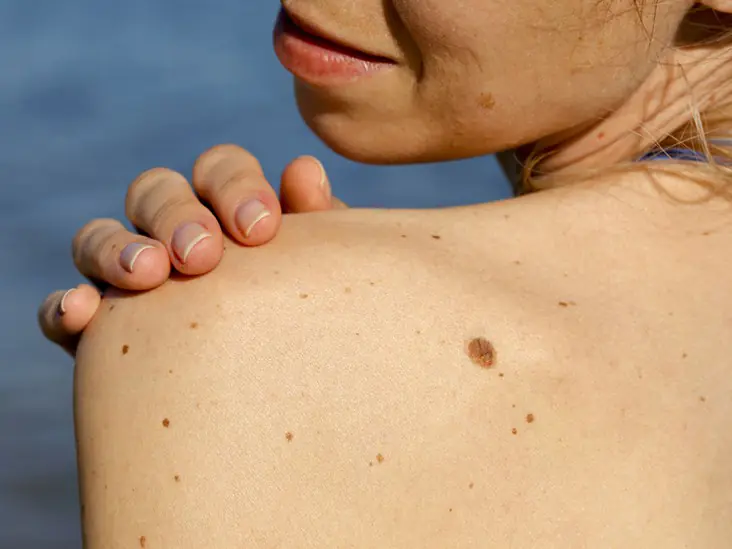
The color of moles depends on the amount of melanin present in the body at the time of their formation. Nevus is a special pigmentation on the skin. It is believed that if many moles appear on the body, then they have roots. Actually this is not true.
Congenital skin defects increase the risk of nevus development. The vast majority of moles are not cancerous. But under certain factors, some of them can develop into malignant ones and lead to serious health problems.
Hormonal causes of moles
If many moles appear on the body, then the reasons may be hidden in a hormonal imbalance. Changes in hormone levels during pregnancy, puberty, or diabetes contribute to the appearance of nevi.
In children with active growth and during the transition period, changes in biochemical growth factors occur. One reason is stem cell activity. With growth, the area of the skin increases, the pituitary gland produces melacortin, a hormone responsible for the synthesis of melanin, the production of corticosteroids in the adrenal cortex and metabolism.
Hormonal changes are not easy to stop, and in some cases cannot be stopped. The appearance of teenage moles is normal, provided that the spots appear evenly and of the correct shape.
You should monitor your hormonal levels if many moles appear on your body. Reasons causing an increase in the number of nevi:
- teenage years;
- pregnancy, after childbirth, after abortion, during menopause in women;
- in men with testicular disease, with a malfunction of the pituitary gland, with increased production of the hormone estrogen;
- severe stress;
- after infectious diseases;
- for skin diseases;
- With age, the number of nevi increases, this is due to hormonal changes and aging of the body.
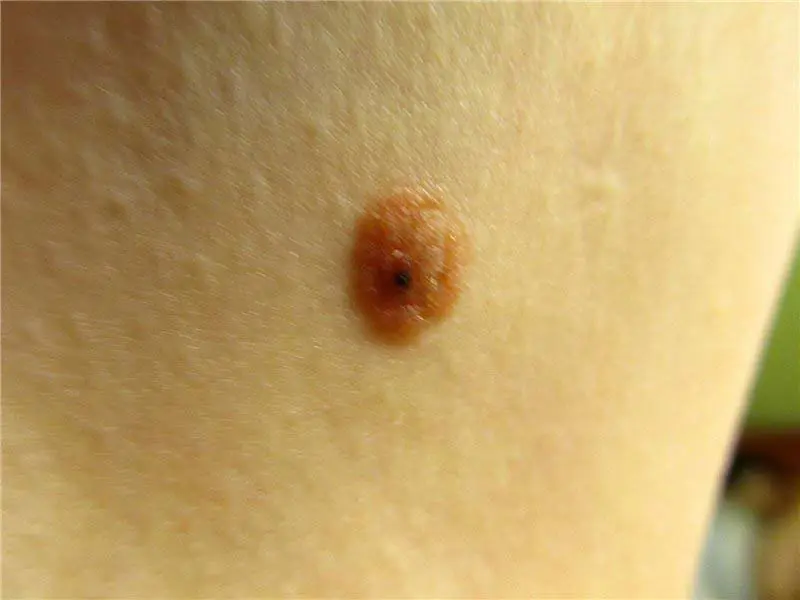
Ultraviolet light is the cause of moles
Melanin production increases under the influence of ultraviolet rays, resulting in a tan. Tyrosine is activated in melanocytes, which helps protect the skin from radiation.
Excessive passion for solarium or tanning leads to an increase in the number of nevi. If many moles appear on the body, then excessive sun exposure is to blame. The biomechanics of the interaction between the skin and the sun's rays is not fully understood, but indirect evidence is the rare formation of nevi on the buttocks.
Moles that increase in size should not be exposed to sunlight. You should not go out in the sun from 11 to 16 hours of the day. After tanning, many moles appear on the body. The appearance of nevi frightens sunbathers.
To reduce the likelihood of new moles appearing, you should give preference to light-colored fabrics in the summer. Excessive radiation can trigger the appearance of cancerous moles, which will rapidly increase in size.
Genetic predisposition and aging of the body
Older people often wonder why there are so many moles on their body. Indeed, observations show that the older a person is, the greater the number of nevi present throughout the skin. One of the reasons is the gradual appearance of moles throughout life, and by old age a large number is formed, which becomes noticeable.
Another reason why there are so many moles on the body as we age is that the skin is thinner than before. Because of this, deep nevi become more noticeable, brighter, and change color to a darker one.
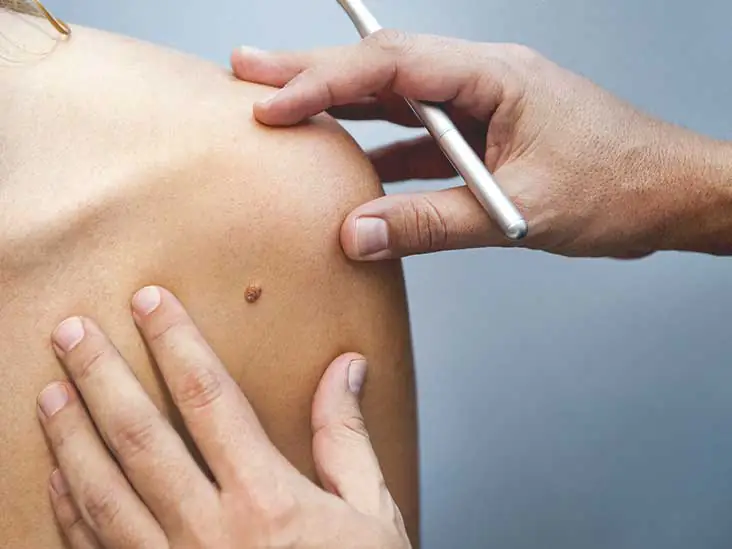
Hormonal age-related changes also provoke an increase in the size and number of moles.
Those people whose closest relatives have a large number of nevi have a greater predisposition to age spots. It is believed that it depends on race, skin color and nationality, as well as genetic code, which increases the risk of developing nevi on the body.
Heredity is not a guarantee that moles will begin to appear in large numbers. Without provoking factors they do not develop.
Red moles
A person begins to worry when red nevi appear, especially if there are a lot of moles on the body. The reasons for the appearance of red dots are not completely clear, but the study of this phenomenon continues. Many theories have been put forward, but none have become an official part of evidence-based medicine.
One of the reasons for the appearance of red nevi is a malfunction of the large intestine or pancreas. But for now this remains a guess.
Another reason for the appearance of red dots is a violation of lipid metabolism and the development of skin pathology.
In any case, if many moles appear on the body in a short time, you should consult a doctor. Based on the results of tests and visual inspection, a specialist will determine whether they should be disposed of and whether they pose a danger to the body.

Moles on legs
Hanging moles are growths on the skin that have a bumpy cap. Color can vary from flesh to dark brown. Sometimes they have a completely invisible stalk or resemble a papilla.
A benign pedunculated mole does not pose a threat to a person, but careless handling of it leads to negative consequences.
Regardless of the color of the nevus, it is based on the pigment melanin, which forms the final color of the mole. The reason for this is a high accumulation of pigment in any area.
Moles on legs can cause the following problems:
- aesthetic discomfort when appearing on the face or neck;
- risk of developing into a malignant neoplasm;
- discomfort when rubbing with clothing or accidentally touching;
- risk of injury, which can lead to the development of cancer, infection and inflammation.
Pedicled moles are not dangerous, but their risk of degeneration into a malignant neoplasm is slightly higher than that of flat moles.
Why are moles dangerous?
Don't panic if you have a lot of moles on your body. The reasons for this should be determined by a doctor. Most nevi are absolutely not dangerous, but it is important to know the symptoms of moles that can become a threat to human health:
- Atypical. They can be recognized immediately when they appear; they have an unclear shape, uneven color and their size is more than 0.5 mm. They are often congenital, can be inherited and require specialist supervision.
Melanotic Hutchinson's freckles form as a flat spot containing two or more shades. They occur at the age of 50 years and older and form on the face. Their size increases, their color becomes darker, and over time they become malignant.
Skin neoplasms of unknown etiology form suddenly; a person sees that many moles have appeared on the body, the causes of which are unclear. In 60% of cases, the phenomenon precedes the development of melanoma.

What you should pay attention to and consult a doctor:
- change in color of the mole, especially in the middle;
- increase in thickness or height;
- the appearance of pain or blood;
- redness, swelling;
- itching or burning in the area of the nevus;
- division into several smaller moles, pieces falling off.
Moles in children
The reasons for the appearance of moles are still unknown. As a rule, a child is born with clear skin, but there are exceptions. Up to 6 months, several inconspicuous spots may appear, which parents do not pay attention to. The older the child gets, the more nevi form. Prolonged exposure to the sun helps to increase their size.
Parents are scared that a teenager has many moles on his body, but this is due to hormonal changes and rarely poses a threat.
Moles are divided into vascular and ordinary. Vascular lesions can range in color from pink to bright red and be flat or convex. Parents should pay attention to the size of the nevus. If it is more than 1 cm or is growing, you should consult a doctor for advice.
If a child picks or scratches a mole, apply a clean bandage and consult a doctor to eliminate the risk of infection and check the mole for good quality.
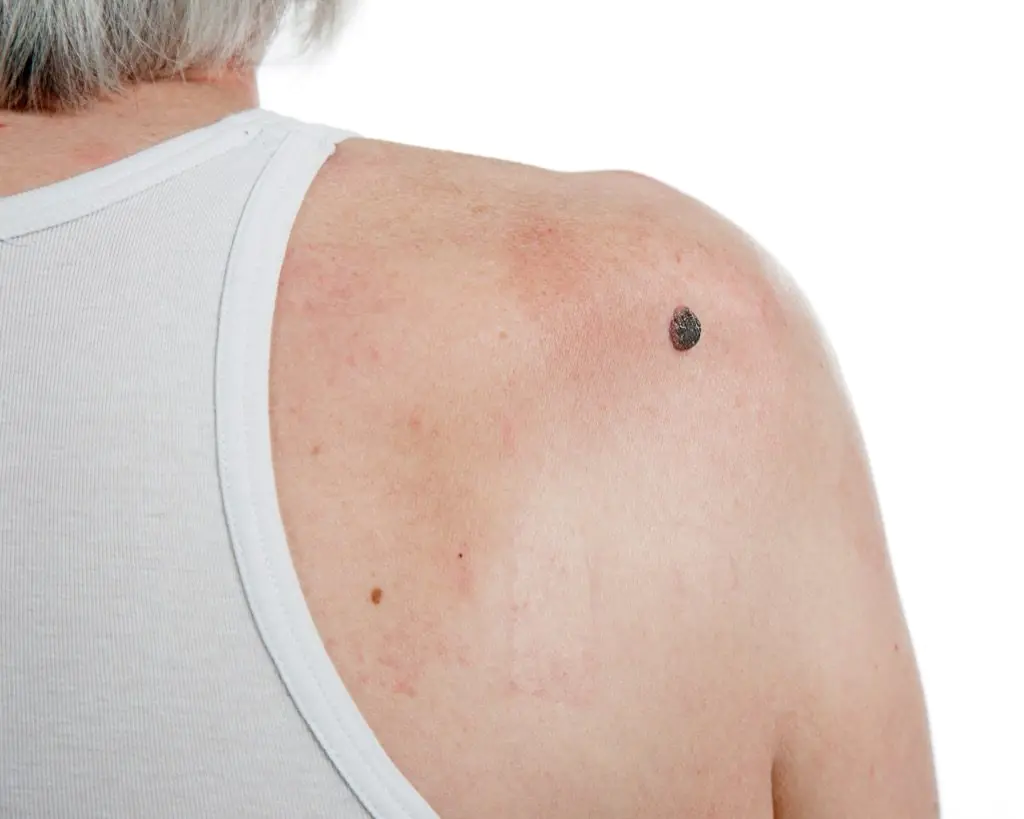
Moles during pregnancy
During pregnancy, many moles may appear on the body. The reasons for the appearance are not always clear, but they are associated with hormonal changes in the body. Neoplasms appear more often in the second trimester.
The appearance of moles indicates that the hormonal system is working properly and can cope with the stress. In some cases, nevi disappear during pregnancy. Often moles disappear after childbirth, but not always.
A darkened nevus during pregnancy indicates an increase in the amount of melanin, which causes the line on the abdomen and areola to darken. A pregnant woman should be alert to moles that have changed in size, lost their clear outline, or become two-colored.
Signs of many moles on the body
People have always treated strange spots on the body with interest. It is believed that the appearance of a nevus indicates an event in a person’s life:
- on the right eyebrow - early marriage;
- on the left eyebrow - an unhappy marriage;
- appears on the left cheek in passionate natures;
- on the right cheek promises success;
- a mole on a woman’s chest speaks of kindness;
- a mole on a man’s stomach is an unshakable character;
- on the shoulder - a calm life;
- on the right hand indicates a housewife, a worker;
- on the left - a lazy person;
- on the ankle indicates an energetic person;
- on the shin - hard work and self-confidence.
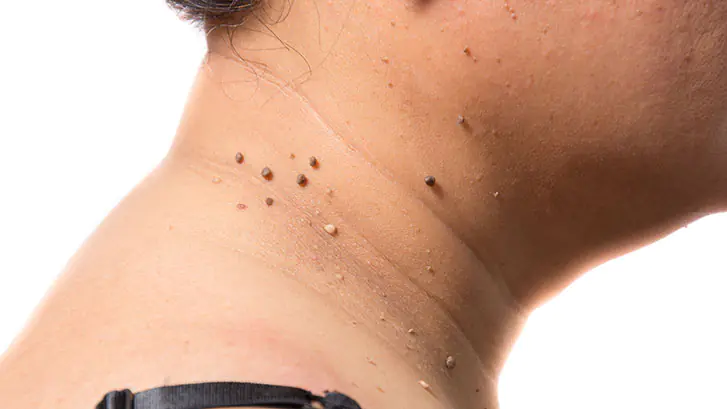
When to see a doctor
The appearance of a large number of moles is not a cause for concern. You should monitor them and consult a doctor if their size increases.
There are ways to reduce the spread of nevi. To do this, use tar soap, creams or ointments. Vitamin complexes help reduce the number of moles.
Particular attention should be paid to the functioning of the endocrine system. Moles require regular monitoring. If itching, thickening or swelling is detected, consultation with a specialist is required. When these symptoms appear, the risk of developing melanoma increases.
Under no circumstances should you remove moles yourself, as this can lead to infection. An examination by a dermatologist will determine the degree of risk and the need for removal.
A person has at least one mole, but some have up to 600. Is this good or bad and why did many moles appear on the body completely unexpectedly? Researchers have found that people with multiple moles have younger-looking skin and better bone density, leading to delayed aging. People think that a mole-shaped birthmark can be very beautiful, but it turns out that it may very well keep you looking younger for longer because the skin cells with moles have properties that allow them to renew themselves more often, and this is a proven fact.
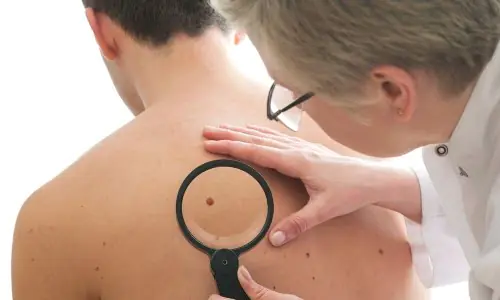
But there is a price that may have to be paid for this delayed aging. A large number of moles is significantly associated with a higher incidence of cancer compared to other skin types. People with cell divisions and a more youthful appearance may have an increased risk of developing cancer.
Dr Bataille, a leading researcher who presented his findings on the issue at Britain's Royal Society of Medicine, said: 'When a patient comes to me with multiple birthmarks, I automatically start to find out their family history of cancer, and I immediately start thinking about prevention. "It's not just melanoma, but also more common cancers like breast cancer and colon cancer."
But there is also good news!
And it is that people with birthmarks have been found to be less vulnerable to some of the effects of skin aging, such as wrinkles and age spots. Also, a recent study of 1,200 twins found that having more moles on the body means these people are less susceptible to age-related decline in bone density, which could mean a lower risk of developing brittle bones and fractures in old age. People with more than 100 moles on their body are half as likely to develop osteoporosis as those with 25 moles or fewer.
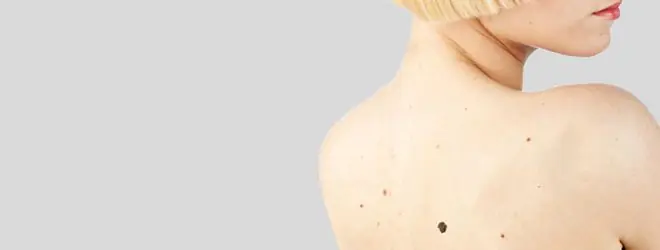
The reason for this is not fully understood, but researchers have noticed that people with birthmarks have differences in the strands of DNA that carry the genetic code in the body's cells. The sections at the ends of these threads are called telomeres, and they are an effective countdown timer that regulates how many times a cell can divide and produce new cells. The longer the telomeres, the more cell divisions can occur throughout life. And a large number of birthmarks are always associated with longer telomeres. Perhaps nanoperforation or microneedling can help solve this problem.
Based on this study and the results obtained, Dr. Bataille suggested that birthmarks are an external manifestation of the system that controls the aging process. When you pay attention to people who have a lot of birthmarks, you will notice that they look better as they age.
Nevus is generally harmless
Most moles are harmless and there is no reason to remove them, but many people who have moles on their face find them unattractive and want to have them removed for cosmetic purposes. Facial moles tend to receive more attention than moles elsewhere on the body. In the 1950s, a dark mole on the cheek was considered a very attractive attribute, and girls often drew artificial nevi on their faces with a pencil. Back in the Middle Ages, they were called flies, and the fashion for them either goes away or comes back again. Cindy Crawford brought it back again with her signature birthmark on her face near her mouth.
Birthmarks are small, dark growths of skin that develop from pigment cells that produce melanin in the skin, but they can be flesh-colored or yellow-brown, they can also be raised above the skin and very noticeable, and they can also grow dark hair. In general, hair on a mole does not make it more dangerous. It is the content of the melanin pigment that causes the brown color of most birthmarks. And if you start to have a lot of moles on your body, it means that the process of intensive reproduction of these very cells that produce and accumulate melanin has begun in your skin. 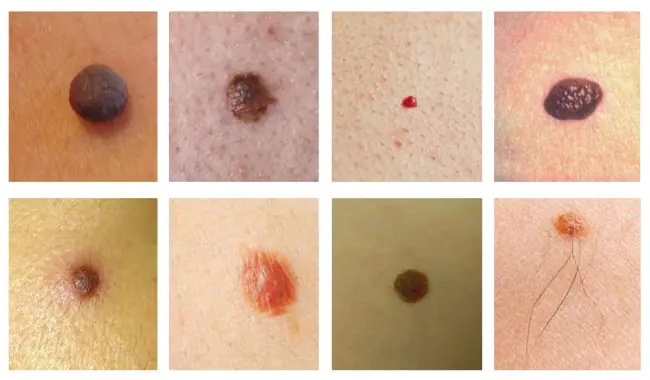
Check out these formations
All birthmarks should be checked regularly. While it's easy to notice moles on the face (because we tend to regularly look at our faces in the mirror), moles in other places can easily be forgotten or overlooked. If you are interested in maintaining your health and prolonging your life, then if you have many moles on your body, immediately go to a dermatologist or personal physician for a full evaluation and screening. This will be an examination of the entire body, not ignoring areas that you are not able to check regularly.
What causes moles to appear, and what are the risk factors for their development?
We inherit genes from our parents, and along with the amount of sun exposure we are exposed to (especially during childhood), these are the main two factors in the number of moles on our body. Skin that was exposed to intense sun exposure during childhood tends to have more moles. However, birthmarks can also appear in areas protected from the sun, such as the palms of the hands, soles of the feet, or genitals.
Both pigmented formations are birthmarks and freckles (in medical terms they are called the same - Ephel >
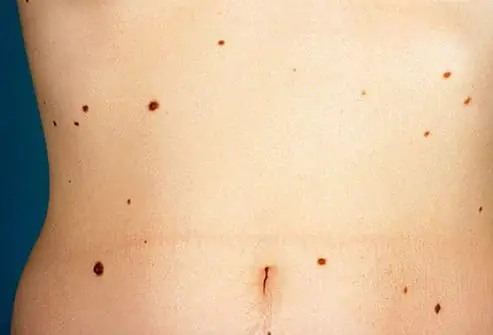
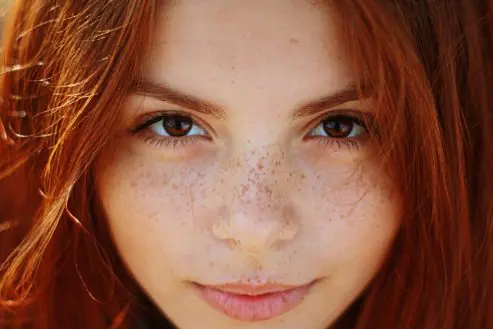
Freckles are flat spots that, like a tan, are slightly reddish or light brown in color. And they usually appear with the onset of sunny months. They are most common in people with fair skin. Many people with blond or red hair and green or blue eyes are more prone to these types of skin spots. Avoiding direct sunlight and using sun protection, including regular use of sunscreen, can suppress the appearance of some types of moles and freckles.
Are children born with moles?
Yes. Moles may be present at birth or gradually appear later in the postpartum period. Many children continue to develop moles into their teens and young adulthood. But they grow very weakly relative to the overall growth of the body. Congenital moles are already present at birth and form during fetal development. Other moles may appear later, as a result of factors that are not genetic but environmental, such as sun exposure.
Can new moles appear in adults?
Yes. Although many moles appear in the first years of life, the total number of moles usually peaks in the second or third decade of life, with an average age of 35. People no longer develop new moles after the age of 30. But adults often develop pigmented spots and growths such as freckles, lentigines, liver spots, and areas of seborrheic keratoses.
What else could it be
There are many skin growths that look like moles or freckles, such as:
- Lentigo,
- liver spots,
- Seborrheic keratosis,
- Melanoma,
- Neurofibroma,
- Hemangioma,
- Skin scars
- Dyes ingrained into the skin
- Pigmented cancerous basal cells, etc.
The best way to differentiate between these and other growths is to consult a dermatologist. Sometimes moles may appear near or on top of another skin lesion, such as a freckle or seborrheic keratosis. When in doubt, a skin biopsy can be very helpful in diagnosis. Therefore, in case of the slightest suspicion, immediately go to a specialist. Remember that malignant skin tumors develop at lightning speed and are practically not treated in advanced stages. Therefore, you cannot waste time, not even a single day!
Skin growths can be dangerous. Today we will talk about moles. Every person has them. Some have one or two, others have their whole body covered. The latter are most interested in the question: why are there so many moles on the body? Is it dangerous? Should they be removed? Moles and the threat from them are completely individual phenomena. They can go their entire lives without bothering their owners. And one inconspicuous nevus can cause a lot of unpleasant troubles. The owner of such marks should carefully monitor their condition and periodically consult with specialists.
Definition of a mole
Doctors call a skin defect a mole. It can be congenital or acquired. This area of skin is characterized by a large amount of melanin. Melanin is a dark pigment that colors the epidermis. Moles are most often benign formations. They can appear absolutely anywhere and have different colors and sizes.
These three types most often characterize flat moles, i.e. they are at the same level as the rest of the skin.
There are also hanging nevi. They certainly look more like warts. But nevertheless they are one of the types of moles. Their color usually does not differ from the main skin. There may be exceptions. For example, nevi are dark brown. They are the ones that cause the most discomfort for owners - sometimes they interfere with normal activities and can be damaged.
Reasons for the appearance of a large number of moles
The number of moles can increase:
- Hormone surges. This is especially observed during pregnancy, menopause and puberty. The fact is that hormones are responsible for the production of melanin. They are produced by the pituitary gland. So there is a direct connection here - more hormone - more moles. By the way, due to the large amount of hormones, moles may disappear. This happens extremely rarely, and in the place of those who disappeared, others come in even greater numbers;
- Heredity. This is something you can't escape from. Some studies prove that the number of moles on the body is directly related to genes;
- Prolonged exposure to the sun. Bronze tan lovers are most susceptible to the formation of new nevi. After all, melanin is produced several times faster when exposed to ultraviolet radiation;
- Frequent x-rays or radiation exposure. These rays have a very aggressive effect on melanin, causing it to accumulate in a certain place, where a new mole later forms. So, people who, due to a disease, often have to resort to these methods of diagnosis and treatment, note the appearance of a large number of new moles on the body.
Precautionary measures
When there are a lot of moles on the body, people often worry whether they will cause the development of cancer, in particular melanoma. This option is, of course, possible. But not only for those who are strewn with nevi. Even one single mole can be a threat.
What people with a large number of moles should avoid:
- Long exposure to the sun, and it is also better not to sunbathe in a solarium;
- Hair growing from a mole can only be trimmed. Plucking or shaving them can cause infection. By the way, such moles will never cause melanoma;
- Do not injure the nevus - do not rip it off, cut it off, etc. Never try to get rid of a mole on your own! If this happens, immediately contact a dermatologist, surgeon or oncologist.
Those with moles should definitely have their nevi examined. Melanoma is very difficult to treat. So it is better to prevent it or detect it in the early stages.
What to look for:
- The size and color of a mole is an alarming signal for any changes;
- Bleeding from a mole;
- Purulent inflammation;
- Changes in the boundaries of the mole - the contours become blurry or, on the contrary, clear.
Treatment methods
The appearance of a large number of moles may depend not only on external factors, but also on internal ones. For example, there is a hidden infection in the body. Then, first of all, it is worth solving this problem and only then dealing with nevi.
In any case, the dermatologist will select the correct treatment strategy. Only a specialist can determine whether a mole is dangerous.
Reasons why nevus is removed:
- Changes in moles that characterize the development of cancer;
- The location of the nevus is in an inconvenient place - the bends of the limbs, close contact with clothing, the face. In these places there is a high risk of mechanical damage to the mole;
- Disruption, damage to a mole.
Before any removal, even of a non-oncological mole, the doctor will prescribe a series of tests - a general blood test, blood for tumor markers, a biopsy of this neoplasm. And only after them can you make a decision about deletion.
There are several options to get rid of a mole:
- Freezing a mole with liquid nitrogen;
- Laser removal;
- Surgical removal;
- Radio wave coagulation.
Signs associated with moles
In the Middle Ages, it was believed that a mole was the mark of the devil. Those with a large number of nevi were simply burned at the stake. Times have changed. Attitudes towards moles too. Although many believe that these are still “marks of fate.” At the end of our article, we will go a little away from medicine and present the most common signs associated with moles.
- Many small moles mean that you are the favorite of fortune, you rarely experience failure, and you have good intuition;
- Red moles are associated with career and wealth. Their sudden appearance may indicate future changes in this area;
- Black moles indicate a strong character. Fate will send their owners serious trials and generous rewards for overcoming them;
- Many moles in children are considered a talisman;
- It is believed that if a young girl has many moles, she will marry successfully.
By the way, moles are as individual as fingerprints. In the whole world you won’t find two people with the same moles. This is precisely what explains the interest of esotericists in such marks on the body.
You definitely need to keep an eye on your moles. And if you suspect any changes, immediately consult a doctor.
Video: why are moles dangerous?
In this video you will learn about ways to remove moles:



